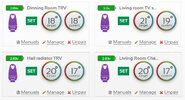One radiator in house should not have a tvr on.
Unless
system has a bypass fitted
The old style was one radiator would always allow flow, however the modern boiler is designed to turn down and then off/on as the TRV's close and a by-pass near the boiler (some times inside it) allows the hot water to quickly return if the TRV's are closed which in turn turns off the boiler.
But my old 20 year old oil boiler is still on the old system with the pump on the return, so a by-pass valve would not work, the idea is since no run on to cool boiler is the DHW and bathroom radiators are not pumped but thermo-syphon some times called gravity, and there is no motorised valve on the DHW so boiler can cool by heating DHW.
However a mechanical TRV has a wide temperature range, around 2ºC or more, so one can set it so the wall thermostat and the TRV work in harmony, so the TRV has not fully closed when the wall thermostat turns off. Traditionally the wall thermostat should be in a room with no alternative heating, including sun through windows, on the ground floor, in a room normally kept cool, with no outside door and no TRV is fitted in that room. However in practice the room rarely exists, so either the TRV is linked to wall thermostat, or set very carefully.
The *123456 does not help, there is no 2.5 = 20ºC as it depends on size of room and radiator, the TRV is analogue, so at 2.5 it will likely start to close at 17ºC but not fully closed until 21ºC so we have three controls to try and adjust to work together, the lock shield sets the speed the radiators heats up, too slow the room never gets warm, too fast and it turns off the wall thermostat before rest of house is warm, and also means the TRV can't turn off the radiator fast enough.
I used electronic TRV to set the lock shield

if the current exceeds target then the lock shield needs closing a bit, unless heated other than central heating, like sun through a bay window. Once set with electronic TRV heads, I found swapping back to mechanical worked great, so I could have used just one and moved room to room.
It worked A1 with mothers house and a gas modulating boiler, but not so well with this house with oil boiler.
This is the problem, we tend to relate to our own system, and there are so many ways which have been used, some one has had a good idea, but failed to tell new owners what that good idea was, saw with one house where the return from the DHW hot coil went through the bathroom radiator, turning off the bathroom radiator resulted in no DHW, who ever had done it clearly thought it was a good idea, the more hot water was used, the hotter the bathroom became, so very warm when you had run a bath.
The house makes a difference too, last house was open plan, no point in TRV's downstairs, only upstairs to stop bedrooms over heating, this house has doors, although training wife to close them seems a problem.


